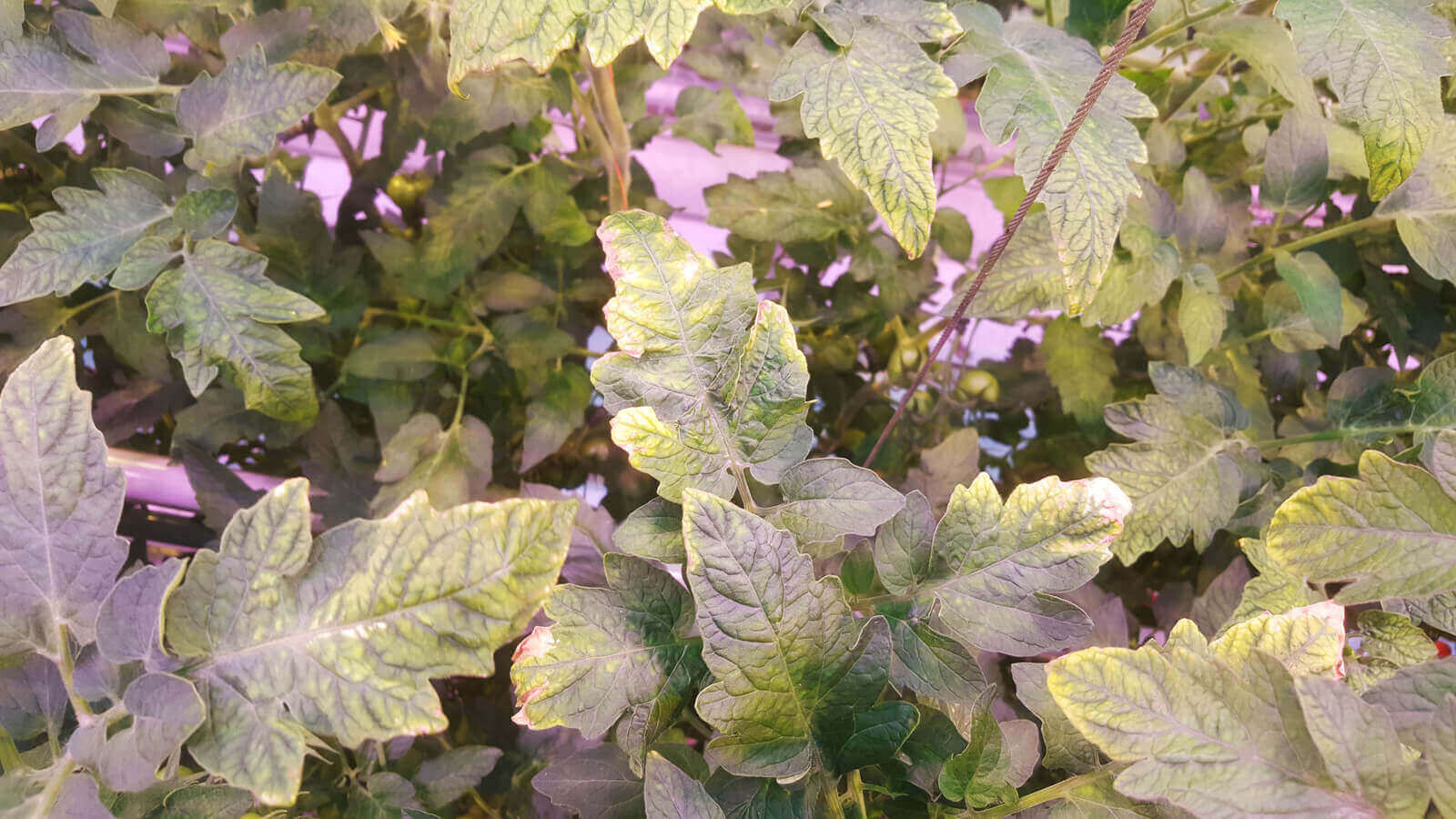
Nutritional disorders: deficiencies – example of the tomato.
There are two types of deficiency: true and induced. We often tend to confuse true and induced deficiencies. It is therefore important to redefine these two types of deficiency.
14 November 2023
There are two types of deficiency: true and induced. We often tend to confuse true and induced deficiencies. It is therefore important to redefine these two types of deficiency.
When nutrients are present in the soil but not available, we speak of induced deficiency. The diagnosis is difficult. In fact, in addition to finding the deficiency, we need to determine its cause. There can be many causes. For example, temperature or pH too high or too low, attacked by a root system pathogen or poor irrigation management.
A true deficiency is due to nutrients present in the soil in too small or too large quantities.
In both cases, a deficiency will have a negative impact on crop yield and quality. In the cases below, we explain the various deficiencies that exist for tomatoes.
Deficiencies appearing on the leaves at the bottom of the plant
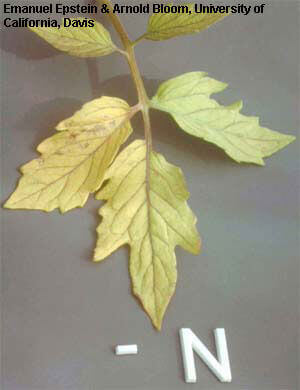
Azote (N)
In the event of nitrogen deficiency, leaves turn pale green to yellow. Nitrogen is a mobile element, so older leaves will experience chlorosis and necrosis earlier than younger leaves in nitrogen deficiency. Nitrogen deficiency leads to stunted growth due to inhibition of cell division. In tomatoes, this deficiency may be accompanied by an accumulation of anthocyanins.
Excess nitrogen leads to vigorous foliage with dark green leaves and a reduced root system, resulting in a high above-ground/root ratio. Conversely, this ratio is low in cases of deficiency. Excess nitrogen also leads to reduced flower formation and cracking of tomato fruit during ripening.
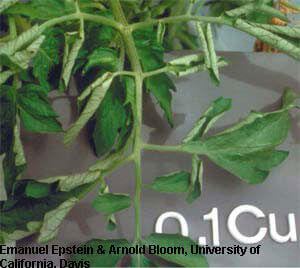
Cu (Cu)
This deficiency is fairly rare in tomatoes. It is characterized by the appearance of pale-green interveinal chlorosis starting at the edge of the leaf blade. The appearance of these chloroses can go as far as necrosis, accompanied by plant wilting and reduced growth.
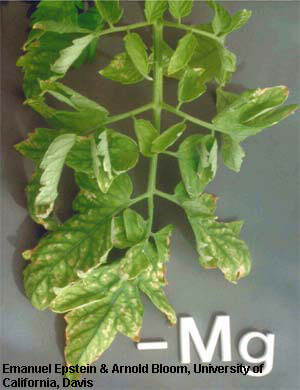
Magnesium (Mg)
Lack of magnesium leads to interveinal chlorosis, which starts at the edges and causes necrotic spots. It also leads to an accumulation of anthocyanin pigments in older leaves. In cases of severe deficiency, interveinal chlorosis progresses to the center of the leaflets.
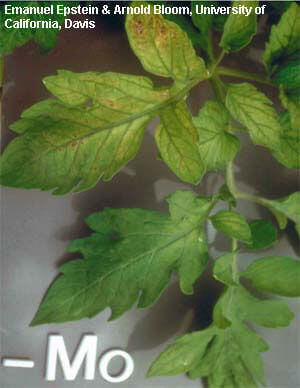
Molybdenum (Mo)
This deficiency is rather rare in tomatoes. It is only under extreme deficiency conditions that symptoms can be observed. Diagnosis is complex, as molybdenum deficiency manifests itself in the form of nitrogen deficiency symptoms. Molybdenum is involved in nitrogen metabolism.
Molybdenum deficiency initially manifests itself in the form of yellowish necrotic spots starting at the edge of the leaf blade on older leaves. As molybdenum is highly mobile in xylem and phloem tissues, symptoms will rapidly appear throughout the plant. Vegetative and root development are greatly reduced.
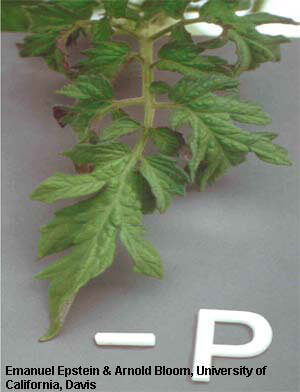
Phosphorus (P)
The amount of phosphorus and nitrogen regulates the ripening process in plants. An excess of nitrogen delays ripening, while an abundance of phosphorus accelerates the ripening process. Phosphate is extracted from senescing leaves and redistributed to various plant organs.
The first symptoms of phosphorus deficiency therefore appear in the older leaves. The result is dark-green leaf discoloration, followed by purple discoloration on the underside of the leaf blade, leaf necrosis, stunted growth and poor vascular tissue formation. The plant may show premature leaf and flower bud drop.
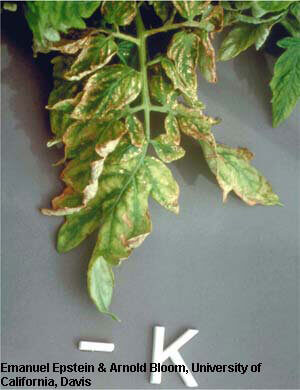
Potassium (K)
Potassium (like nitrogen and phosphorus) is also easily redistributed from mature to younger organs, so deficiency symptoms first appear in older leaves. Potassium deficiency causes interveinal necrosis or chlorosis and leads to the formation of burnt leaf tips.
Potassium-deficient plants also show short internodes and a loss of apical dominance. The result can be a higher risk of pathogen attack, wilting, chlorosis, brown spots and cold and heat damage.
Deficiencies appear on the leaves at the top of the plant.
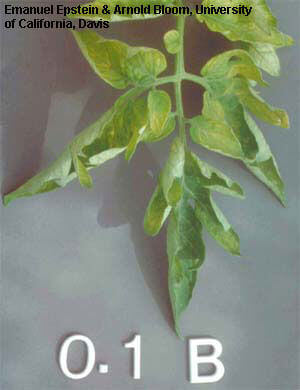
Boron (Bo)
Its deficiency is not very frequent. It causes slight chlorosis and necrosis of young leaves, which then become deformed. Boron is involved in nucleic acid synthesis during cell division in apical meristems, leading to loss of apical dominance, death of root and shoot tips, abscission of flowers and shortening of internodes.
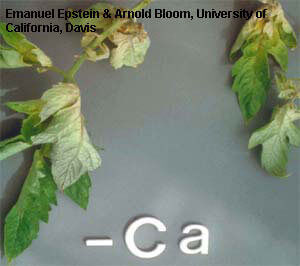
Calcium (Ca)
As calcium is not loaded into the phloem and is not very mobile, deficiency symptoms first appear on young leaves. The edges of the leaf blades will be pale green, with necrotic spots appearing over time. The meristematic tissues of roots, stems and leaves are rapidly affected by the deficiency. It will cause the formation of twisted, deformed tissues or stunted growth, leading to rapid death of meristematic tissues, particularly root meristems. In tomatoes, calcium deficiency leads to degeneration of young fruit.
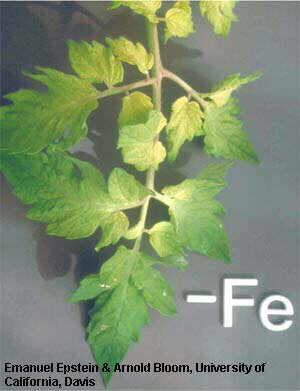
Iron (Fe)
The toxicity and insolubility of iron as a free ion are two major problems for plants. To ensure iron acquisition from the soil and to avoid excess iron in the cells, assimilation and homeostasis are tightly controlled. Iron deficiency is often due to its insolubility in the soil, rather than its absence. Iron is one of the most immobile elements in plants. Its deficiency induces interveinal chlorosis and necrosis, as with magnesium. However, unlike magnesium, symptoms first appear in younger leaves. Interveinal chlorosis is preceded by vein chlorosis, which turns the whole leaf yellow. As the deficiency worsens, young leaves turn white with necrotic lesions.
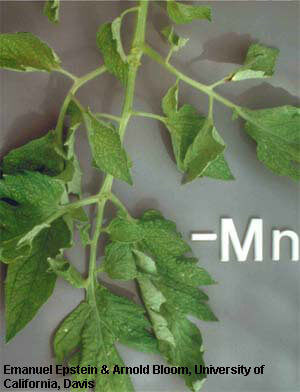
Manganese (Mn)
Manganese deficiency causes interveinal chlorosis and gray spots on young leaflets. It also causes color anomalies, such as discolored spots on the foliage. The veins are not affected. As the deficiency worsens, old leaves turn yellow.
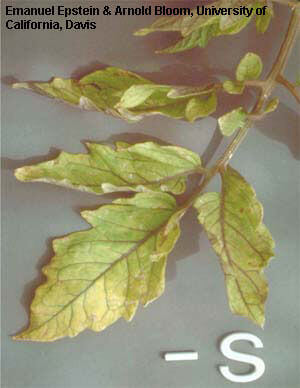
Sulfur (S)
Sulfur deficiency is not very common and is an immobile element. Consequently, symptoms of sulfur deficiency first appear on the youngest tissues. This leads to chlorosis of young leaflets, a pale green/yellowish tint, stunted growth and an accumulation of anthocyanins in the stem and petiole.
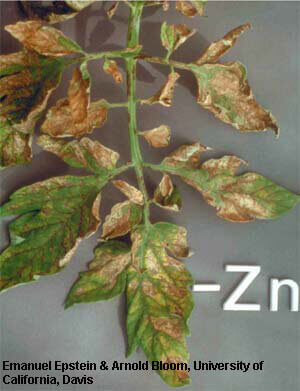
Zinc (Zn)
Zinc deficiency induces chlorosis and interveinal necrosis of young leaflets. They take on a “stunted” appearance, and leaf margins are often deformed and wrinkled, with stunted growth.
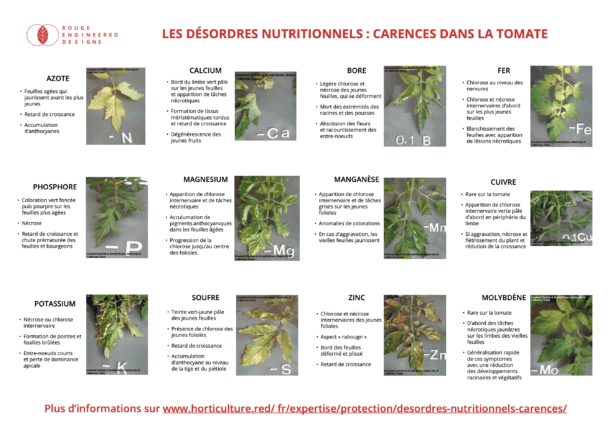
Download your summary poster.
By entering your email address, you agree to receive our latest news by email. You can unsubscribe at any time using the unsubscribe links or by contacting us. For more information, please consult our privacy policy.


